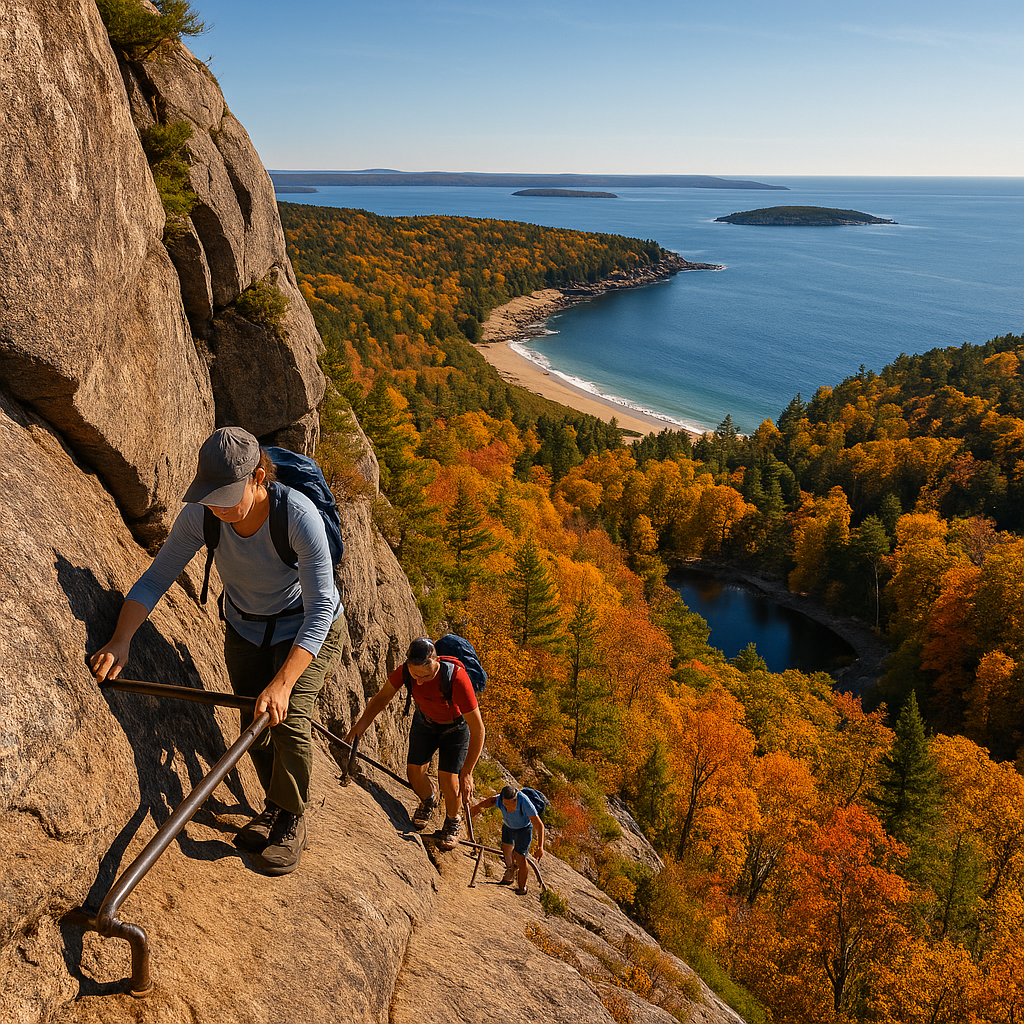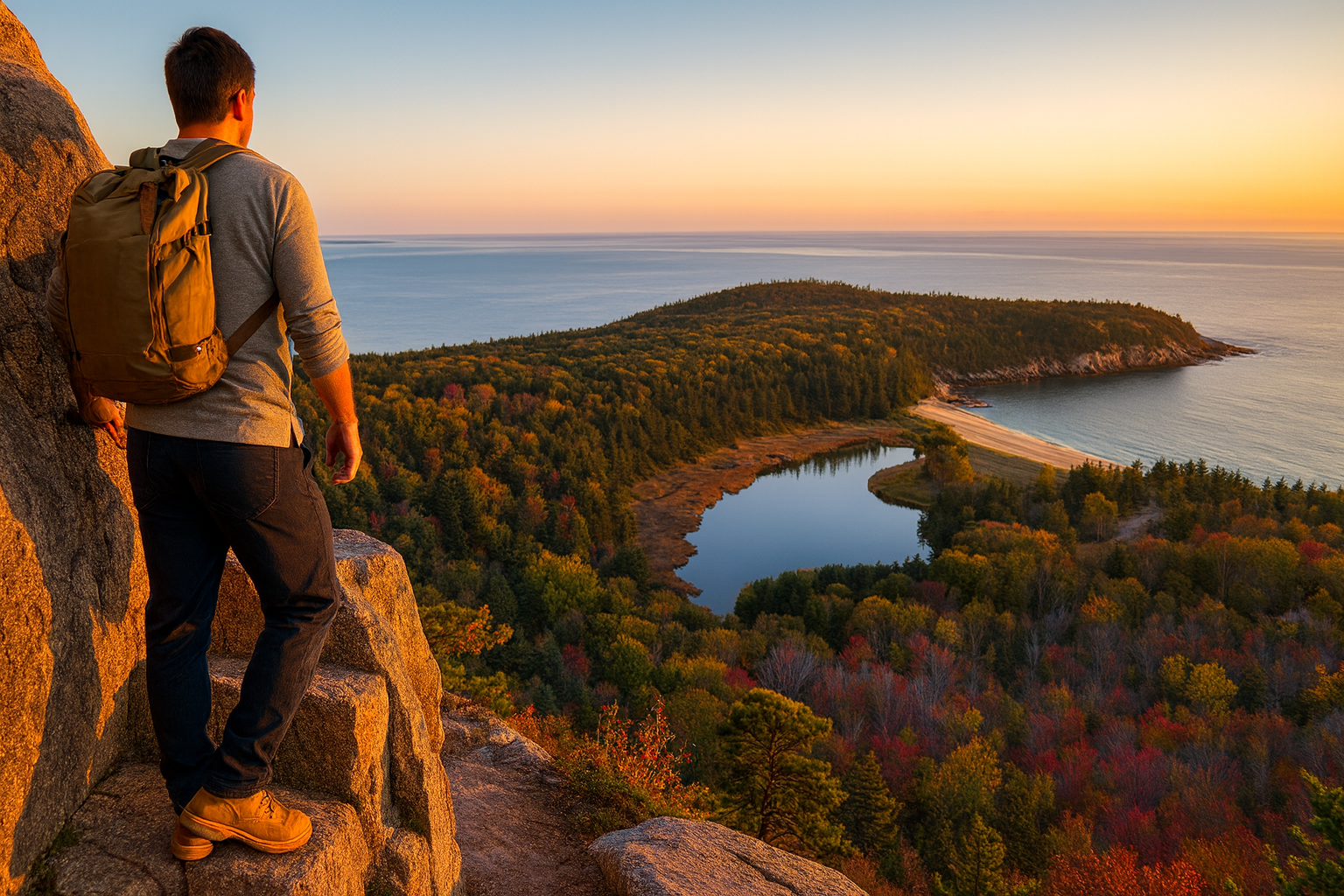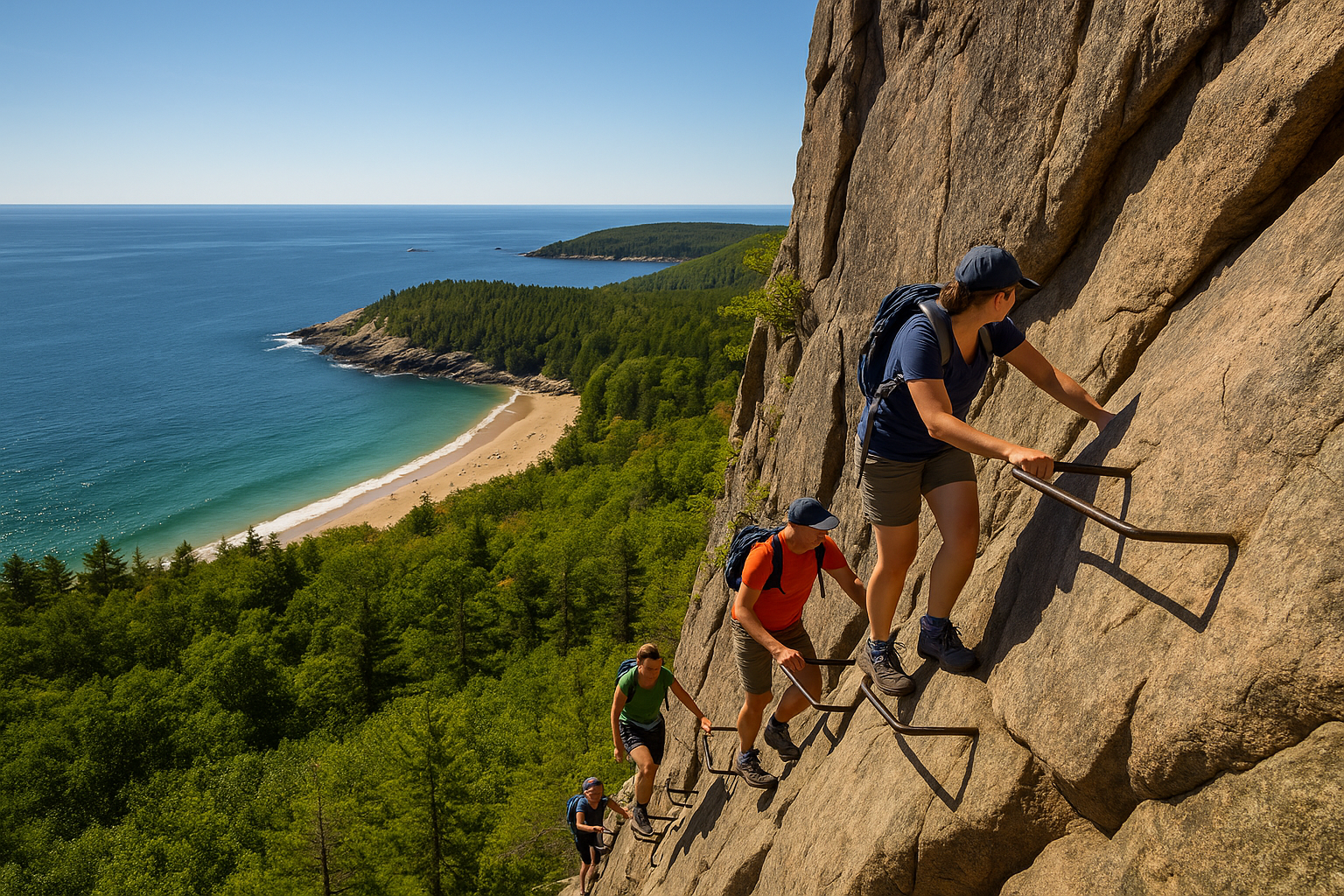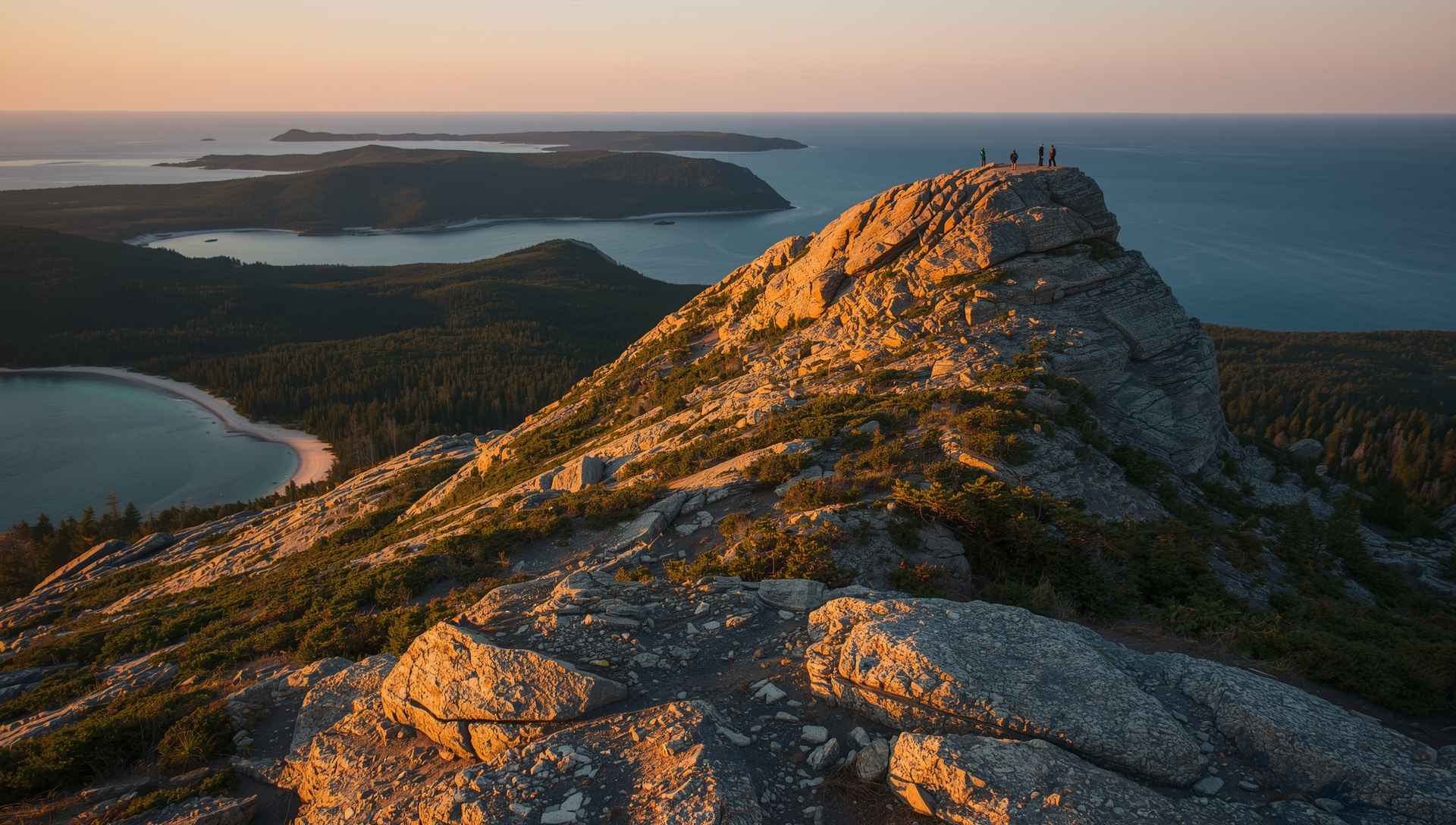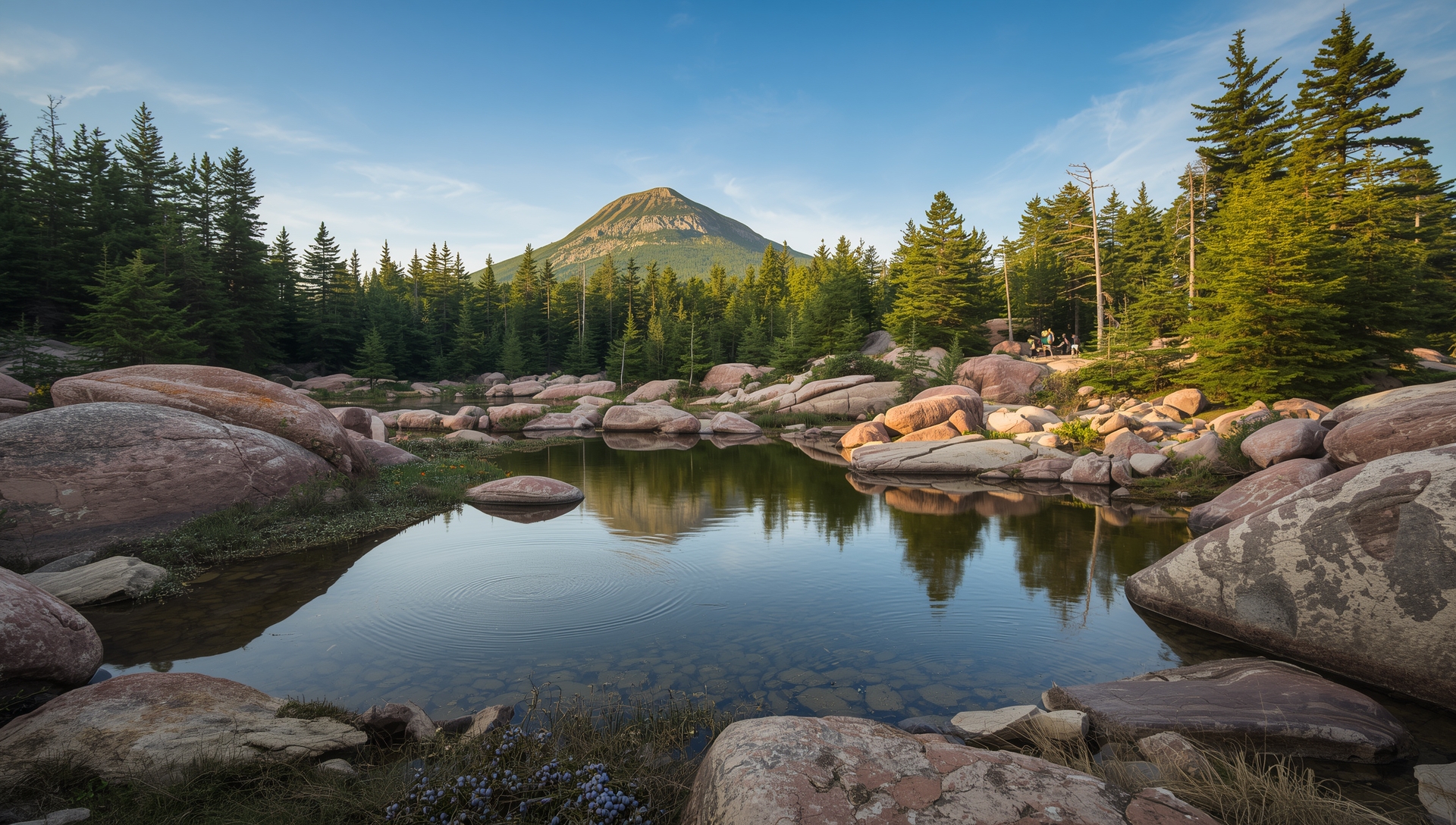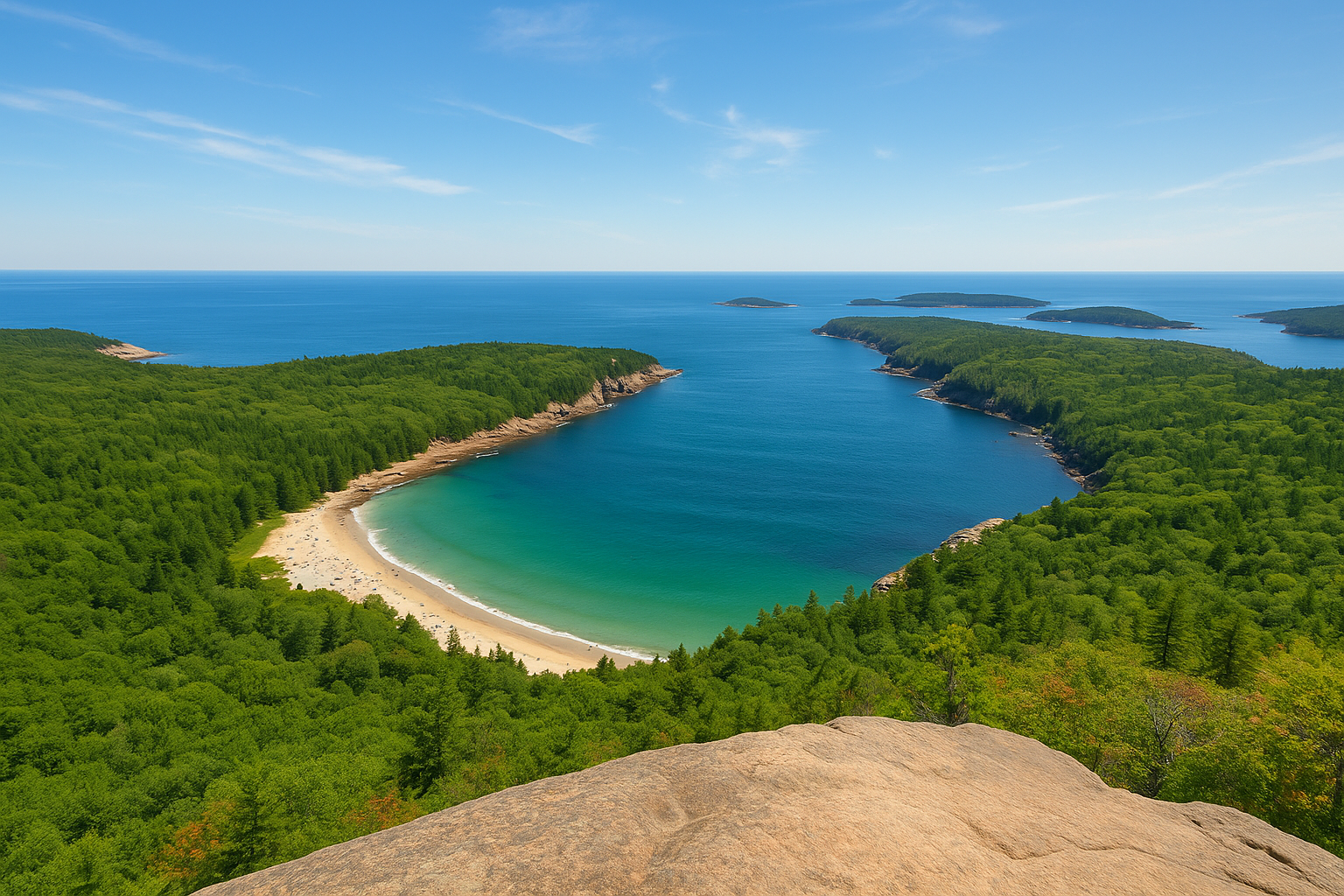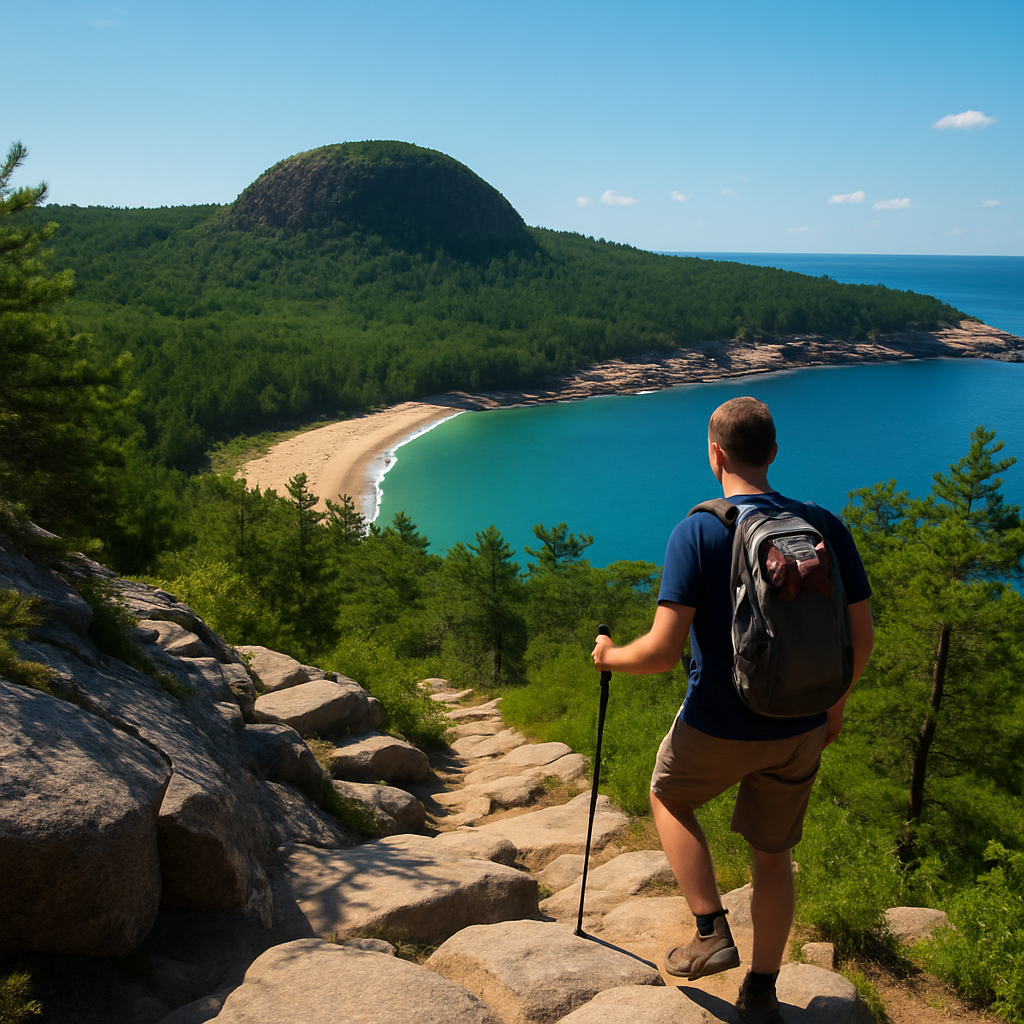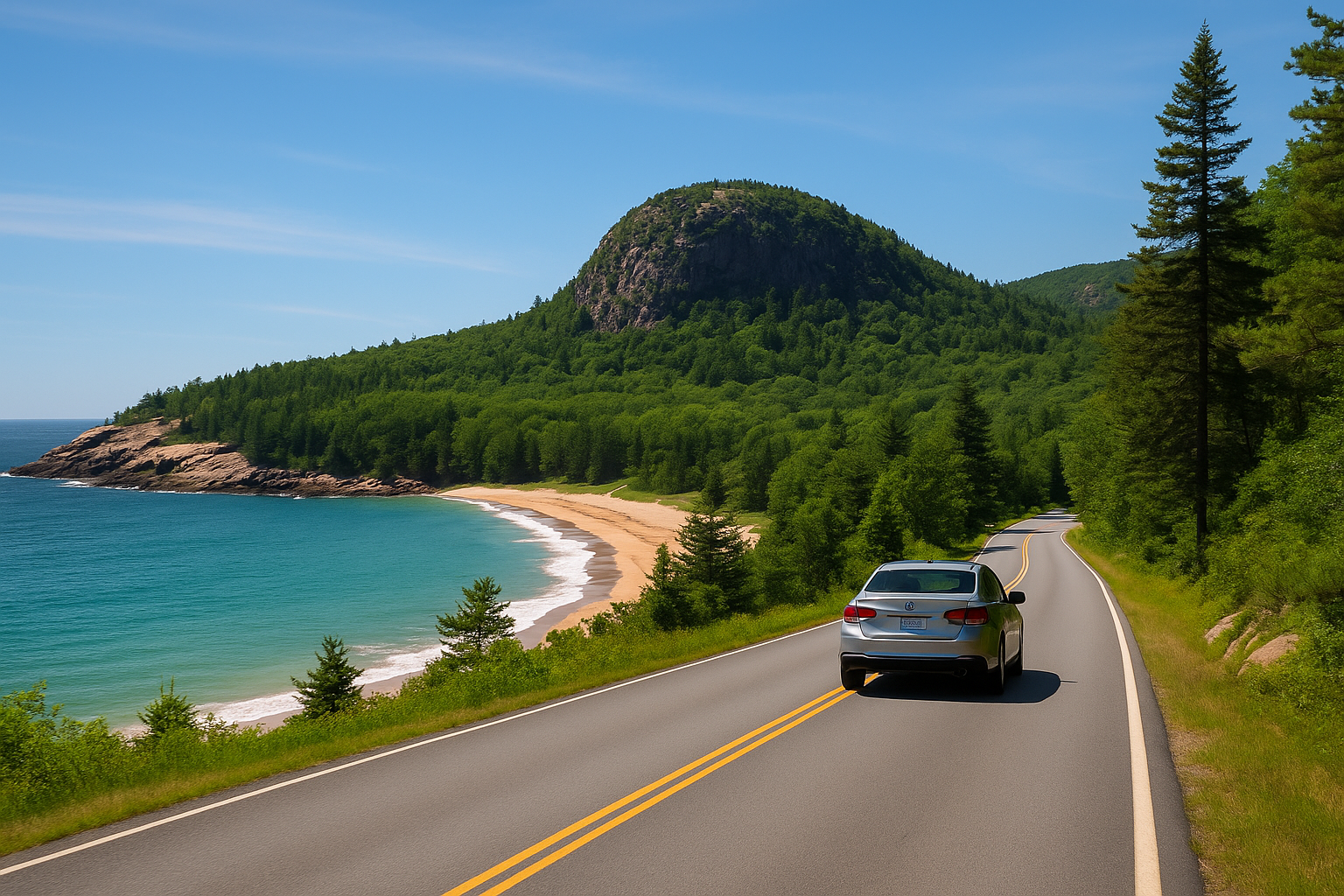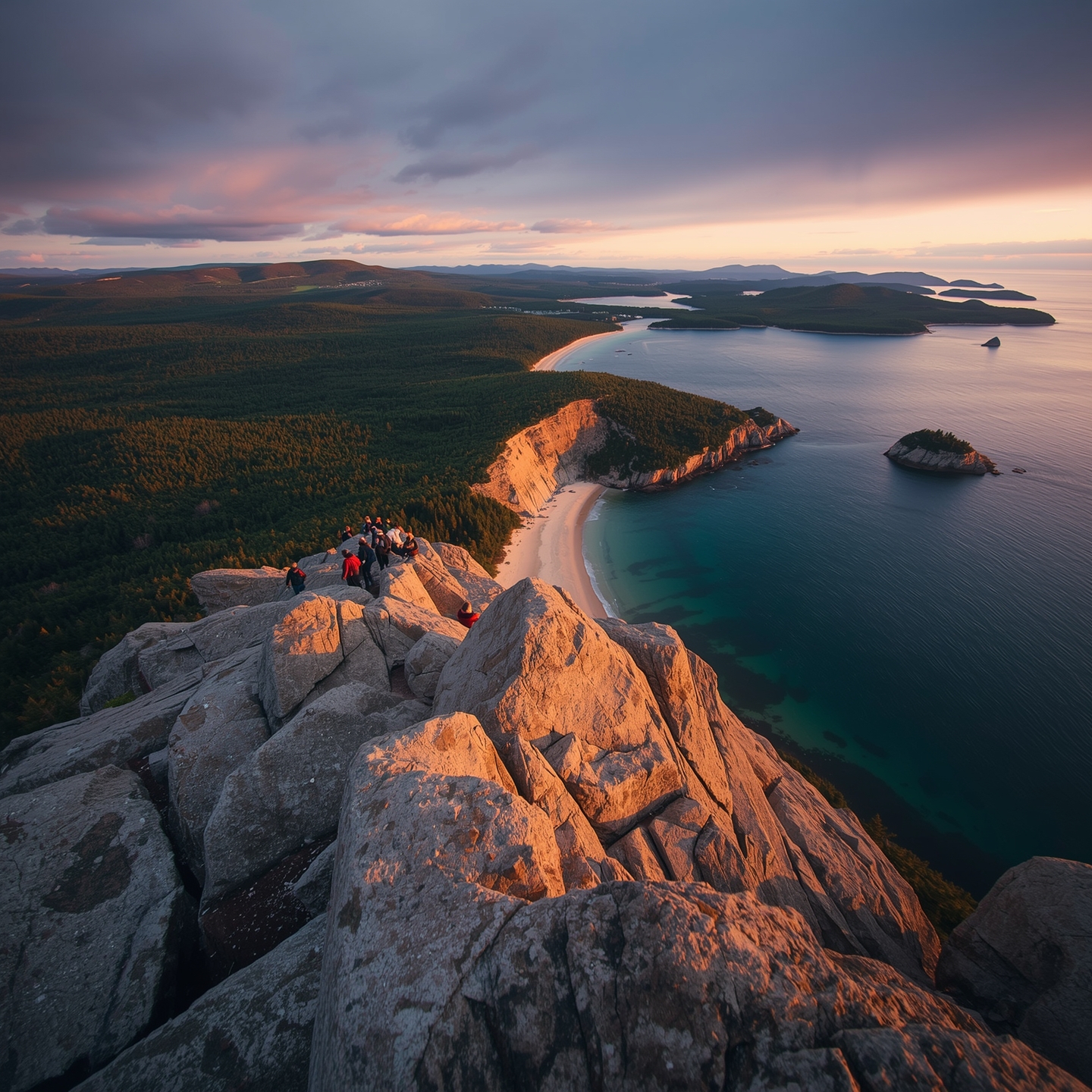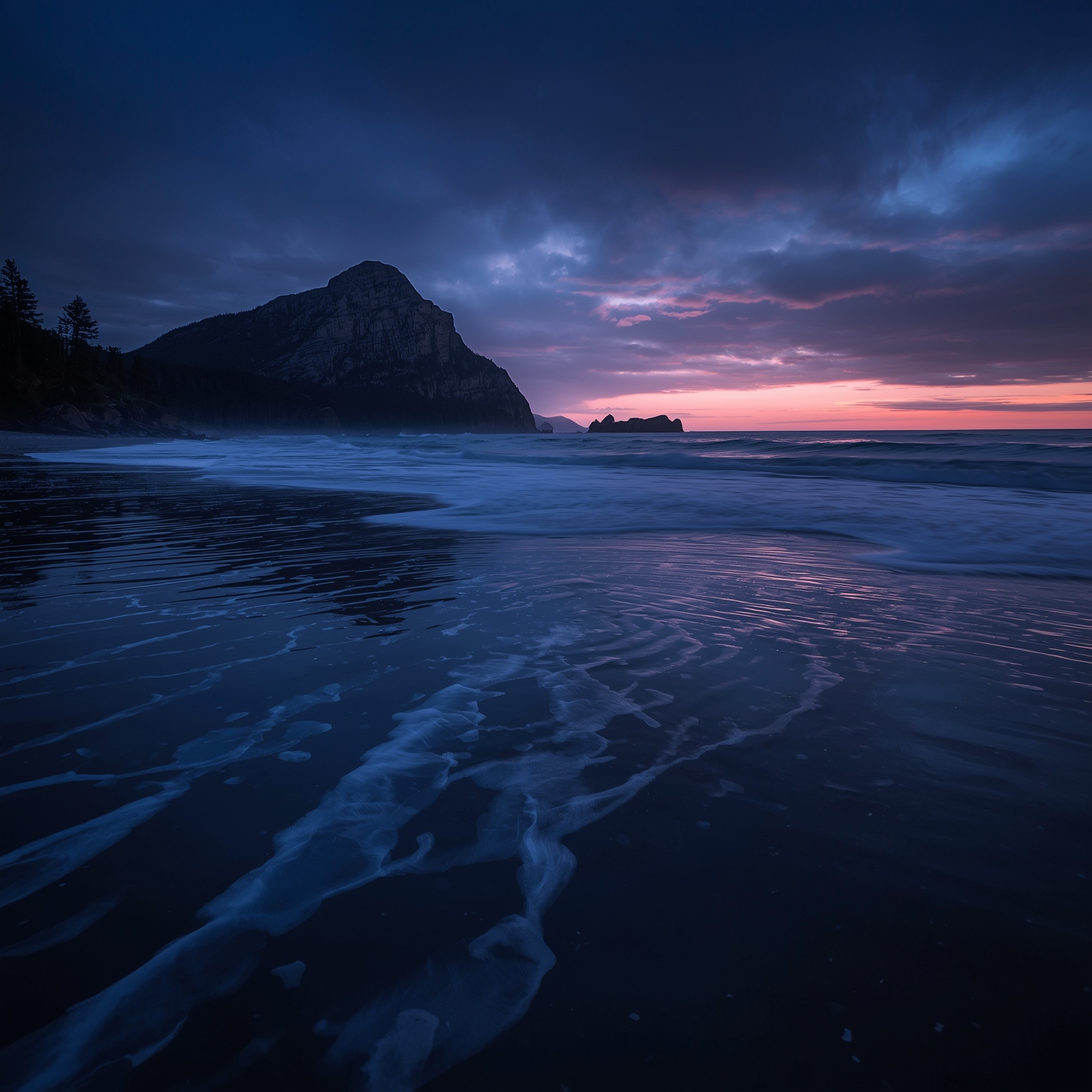Beehive Mountain
Introduction to Beehive Mountain
Beehive Mountain Acadia National Park may rise only 520 feet above the Atlantic, yet few summits in Maine deliver such a surge of excitement in such a short distance. Perched directly above Sand Beach Acadia and visible from the Park Loop Road, the Beehive stands out instantly — its rounded granite dome and steep cliff face forming one of Acadia’s most iconic silhouettes. For many visitors, this small but striking peak perfectly captures the park’s adventurous spirit: a short, steep, and heart-pounding climb that rewards every ounce of effort with sweeping ocean views.
Unlike the longer, meandering ascents of Acadia National Park Cadillac Mountain or Champlain Mountain Acadia National Park, the Beehive Trail Acadia condenses Acadia’s drama into a single, compact challenge. In less than a mile, hikers scale iron rungs bolted into exposed rock, edge along narrow granite ledges, and traverse cliff faces that drop hundreds of feet toward the surf below. It’s a route that demands focus but rewards courage — the kind of climb that transforms apprehension into exhilaration within minutes.
Because the trailhead sits just across from Sand Beach, the Beehive is easily accessible even for visitors with limited time. Families often stop at the base to watch hikers inching along the ledges, while thrill-seekers make it a bucket-list climb. The proximity to Bar Harbor, coupled with its unforgettable ocean backdrop, ensures that nearly every hiker leaves with a photo and a story to tell.
The combination of accessibility, adrenaline, and breathtaking scenery has made Beehive Mountain Maine one of the most photographed and talked-about hikes in Acadia National Park. Whether you’re chasing an early-morning sunrise or testing your nerves on the granite, the Beehive offers an adventure that perfectly captures the wild, untamed beauty of coastal Maine.
• Height: 520 feet (160 m)
• Location: Eastern side of Mount Desert Island, Acadia National Park, Maine
• Famous for: The Beehive Trail Acadia — steep climb with iron rungs and exposed granite ledges
• Best views: Sand Beach, Frenchman Bay, and the Porcupine Islands
• Difficulty: Short but strenuous; not recommended for small children or those afraid of heights
Why Hike Beehive Mountain Acadia National Park?
Beehive Mountain Acadia National Park may rise only 520 feet, but it delivers one of the park’s biggest thrills. Unlike Cadillac Mountain, which can be reached by car, or Champlain Mountain, which offers long ridge hikes, the Beehive is all about intensity. Its famous Beehive Trail Acadia packs iron rungs, cliffside scrambles, and panoramic views into a short, steep climb that feels more like an adventure than a walk. The exposed ledges and ladder-like ascents make it a magnet for adventurous hikers looking for something beyond a casual stroll.
The mountain’s dramatic granite dome towers directly above Sand Beach, making it one of the most photographed peaks on Mount Desert Island. From the summit, hikers are rewarded with sweeping views of Frenchman Bay, the Porcupine Islands, and the rugged Atlantic coastline. On crisp mornings, the rising sun paints the granite cliffs a soft pink, while in autumn the surrounding forests blaze with color — a sight that photographers travel the world to capture.
Those climbing the Acadia Beehive Trail often pause mid-ascent, not only to catch their breath but to marvel at the dizzying perspective of Sand Beach far below. It’s one of the few hikes in Acadia National Park where the ocean feels close enough to touch. Because of its compact size and breathtaking scenery, the Beehive Acadia National Park hike has become a rite of passage for first-time visitors and repeat adventurers alike.
For those who want to enjoy the beauty without the vertical challenge, the Bowl Trail provides a gentler alternative. This peaceful path meanders through quiet forest and around a glacial pond before connecting with the Beehive’s upper ledges. Families and cautious hikers often choose this loop for its serenity and safety — it delivers much of the same ocean view without the adrenaline of the cliffside climb.
What sets The Beehive Mountain apart is how much it offers in such a short distance. In less than two hours, hikers experience Acadia’s signature blend of granite, forest, and sea. The Beehive Hike Acadia combines physical challenge, natural drama, and sweeping views — an experience that feels far larger than its modest height suggests. Whether you’re chasing a thrill, photographing fall foliage, or checking off an Acadia National Park Beehive Trail bucket-list experience, Beehive Mountain delivers heart-pounding excitement and timeless scenery.
In the end, Beehive Mountain Maine proves that adventure in Acadia isn’t measured by elevation but by emotion. It’s not the tallest, but it might just be the most unforgettable climb in the park — one that captures the daring spirit and wild beauty that make Acadia unlike anywhere else.
• The iron rungs along the Beehive Trail Acadia can be slippery after rain — wear shoes with reliable grip.
• Start early in the morning to avoid crowds at Sand Beach and enjoy golden light for photos over Frenchman Bay.
• If heights make you uneasy, consider the Bowl Trail loop — a gentler way to reach views near the Beehive Acadia National Park summit.
• Bring plenty of water — even though the hike is short, it’s steep, sunny, and fully exposed in sections.
🌲 Did You Know?
• The Beehive Mountain was once called the “Baby Precipice” because its iron rungs and cliffside ladders resemble those of the tougher Precipice Trail.
• From October to March, the summit of Beehive Mountain Maine is one of the first places in the U.S. to catch the sunrise.
• The Bowl — the glacial pond at the mountain’s base — was carved thousands of years ago by retreating ice sheets.
• The Beehive Hike Acadia delivers world-class views in under two hours — proof that Acadia’s best adventures don’t always require long treks.
Why Beehive Mountain Acadia National Park Matters!
Beehive Mountain Acadia National Park may not rise as high as Cadillac Mountain or Champlain Mountain, but what it lacks in height it more than makes up for in heart, challenge, and reputation. This compact granite dome has become one of Acadia National Park’s most famous landmarks — a magnet for hikers, photographers, and nature enthusiasts drawn to its dramatic cliffs and unmatched coastal setting. From the moment it comes into view above Sand Beach, the Beehive’s bold symmetry and sheer face demand attention, standing as a granite symbol of Acadia’s wild and rugged character.
What makes Beehive Mountain Acadia truly legendary is its namesake route, the Beehive Trail Acadia — one of the most exhilarating short climbs anywhere in New England. The trail is a masterpiece of design and drama: a series of iron rungs, narrow ledges, and airy scrambles that turn a modest 520-foot ascent into an unforgettable vertical adventure. In less than a mile, hikers move from shady spruce forest to exposed granite ledges, each step revealing new perspectives over Frenchman Bay, the Porcupine Islands, and the open Atlantic beyond. For many visitors, this brief but bold route is their defining Acadia experience — a perfect balance of adrenaline and beauty.
Halfway up the Acadia Beehive Trail, there’s a moment that perfectly captures its essence: the mix of awe and focus as you look down toward Sand Beach gleaming far below. The height isn’t extreme, yet the feeling is electric — the same combination of exposure and accomplishment that leaves hikers grinning at the summit. From there, the view stretches from the shimmering shoreline of Mount Desert Island to the distant sparkle of Bar Harbor. It’s no wonder the Beehive Acadia National Park climb consistently ranks among the most photographed and talked-about hikes in Maine.
Yet Beehive’s significance isn’t just visual or physical — it’s ecological. Once barren of raptors, these cliffs are now home again to peregrine falcons, a symbol of successful conservation. Each spring, portions of the Beehive Hike Acadia and the adjacent Precipice Trail are closed to protect nesting birds. Visitors who return in late summer often spot falcons wheeling through the thermals above the ledges, a sight that ties Acadia’s human and natural stories together. Beehive’s popularity is a testament to this balance — adventure tempered by respect for the landscape and its wildlife.
Accessibility also helps explain the mountain’s fame. Sitting right off the Park Loop Road, opposite Sand Beach and only minutes from downtown Bar Harbor, the Beehive Mountain Maine trailhead is one of the most easily reached in the park. This convenience means that even time-pressed visitors can experience a world-class hike without committing an entire day. Those wary of heights can opt for The Bowl Trail, a scenic, lower-stress loop that passes a glacial pond before joining the Beehive’s upper ledges. The result is a mountain that welcomes everyone — from thrill-seekers scaling the iron rungs to families enjoying gentle forest walks.
For such a small peak, The Beehive Mountain packs in everything Acadia represents: ocean-carved beauty, challenge, community, and renewal. It’s the perfect intersection of wild scenery and accessibility, danger and safety, solitude and shared experience. Whether you come for the climb, the sunrise, or the view from the top, Beehive Mountain Acadia National Park leaves an imprint that lasts long after the hike is done. In the end, it reminds visitors that greatness in nature isn’t always measured in altitude — sometimes it’s measured in awe
• The Beehive Mountain Acadia trail is less than a mile long yet climbs more than 450 feet using iron rungs, stone steps, and exposed granite ledges.
• From the summit, hikers enjoy a straight-down view of Sand Beach and sweeping panoramas of Frenchman Bay — one of the most iconic vistas in Acadia National Park.
• Peregrine falcons often nest on these cliffs. Like the tougher Precipice Trail on Champlain Mountain, the Acadia Beehive Trail closes each spring to protect nesting birds until the chicks have fledged.
• Despite its steepness, the Beehive Hike Acadia remains one of the park’s most photographed adventures, combining ocean scenery with a sense of real accomplishment.
• Sometimes called a “Mini Precipice,” the Beehive Trail Acadia offers similar thrills — airy exposure, iron rungs, and unforgettable views — in a shorter, more approachable climb.
• The Beehive Mountain Maine experience distills Acadia’s wild coastal spirit into less than two hours on the trail.
The Beehive Trail: Iconic and Intense
The Beehive Trail Acadia National Park is one of the park’s most iconic and exhilarating hikes — a compact route that delivers maximum drama in minimal distance. In less than half a mile, this short but demanding path climbs nearly 500 feet, leading hikers up iron rungs bolted into sheer granite cliffs, across narrow ledges with dizzying drops, and over exposed scrambles that demand equal parts courage and concentration. It’s less a woodland walk and more a miniature alpine ascent, framed by endless ocean views and the hum of sea wind. Every step requires focus, yet every pause rewards with views so striking they redefine the word unforgettable.
From the very first rung, the rewards begin. Below, Sand Beach curves like a crescent of pale gold against turquoise surf, while beyond it Frenchman Bay sparkles under the morning light. As you climb higher, the panorama widens — the Porcupine Islands rise from the water like stepping stones to the horizon, and Acadia’s pink granite ridges unfold in sculpted layers. By the time you reach the upper ledges of Beehive Mountain Acadia, you’re standing in a place where ocean, forest, and rock meet in perfect equilibrium — a view as thrilling as the climb itself.
Many visitors describe the Acadia Beehive Trail as a bucket-list experience, and it’s easy to see why. In under an hour, it compresses the grandeur of Acadia’s coastal cliffs, sweeping views, and adventurous climbing into one unforgettable package. The ascent is brief but bold, proof that adventure in Acadia isn’t defined by height but by intensity. The Beehive Hike Acadia is a pure adrenaline hit wrapped in natural beauty — a trail that commands respect even as it captivates the imagination.
Because of its steepness and exposure, the Beehive is not recommended for small children, hikers with vertigo, or anyone venturing out in wet or icy weather. The granite ledges can become dangerously slick, and strong coastal winds add an extra challenge. While rare, incidents have occurred on this route, prompting ongoing ranger reminders to wear proper footwear, keep three points of contact on the rungs, and let faster climbers pass at narrow sections. The Beehive Trail Acadia Dangerous reputation stems less from risk than from respect — a reminder that this trail demands awareness and preparation. Rangers also close sections each spring to protect nesting peregrine falcons, a conservation success story shared with the neighboring Precipice Trail.
For those who want the views without the vertigo, the Bowl Trail offers a scenic alternative. This gentler loop passes through quiet forest and around a glassy glacial pond before winding upward to join the Beehive’s summit ledges. Families and photographers often choose this route for its serenity and reflection views — a tranquil counterpoint to the drama of the iron rungs.
Still, nothing compares to the raw energy of The Beehive Mountain climb. Standing on the final ledge, with waves crashing hundreds of feet below and gulls wheeling overhead, it’s easy to see why this route defines the Acadian experience. Whether you’re chasing a thrill, facing your fears, or simply soaking in the view, the Beehive Trail Acadia distills everything that makes this park extraordinary. It’s not just a hike — it’s a vertical adventure that leaves a lasting impression, a short but unforgettable summit that proves why Beehive Mountain Maine remains one of the crown jewels of the Mountains in Acadia National Park.
• The Beehive Trail Acadia is exhilarating but exposed — sections of iron rungs and ledges drop steeply toward Sand Beach.
• Rangers advise avoiding the trail in rain, wind, or fog, when granite becomes slick and visibility is low.
• Although rare, accidents on the Acadia Beehive Trail have occurred — take your time and maintain three points of contact.
• Use the Bowl Trail as an easier return or alternate route.
• Download the official Beehive Trail Acadia map before your hike and check for any falcon-nesting closures.
The Bowl Trail Acadia National Park: A Safer Alternative
Not everyone who visits Beehive Mountain Acadia National Park is eager to climb iron rungs or inch across narrow ledges — and that’s where The Bowl Trail Acadia National Park shines. This 1.4-mile loop offers a calmer, more scenic way to experience the Beehive’s beauty without the exposure or adrenaline. Beginning from the same trailhead near Sand Beach, the route winds through stands of spruce and fir, climbing gently over granite steps and root-laced forest paths before emerging onto open ledges near the summit. Instead of clinging to cliffs, hikers enjoy a measured, rhythmic ascent shaded by evergreens, making it ideal for families, first-time visitors, or anyone who prefers a steadier pace.
The trail’s namesake feature — The Bowl — lies nestled at the base of Beehive Mountain Maine, a serene glacial pond that mirrors the surrounding cliffs. Protected on all sides, its surface is often still as glass, disturbed only by the flutter of dragonflies or the haunting call of a loon. The air is cooler here, scented with pine and damp stone. Many hikers pause at this tranquil spot to rest or picnic, their reflections mingling with those of the granite walls rising above. It’s a place where Acadia’s wilder energy seems to pause and breathe.
From The Bowl, the path curves upward through soft moss and fern-lined rock, gradually gaining elevation until the forest opens to reveal the same ledges reached by the steeper Beehive Trail Acadia. Here, hikers are greeted with classic Acadia National Park vistas: the blue arc of Frenchman Bay, the small green humps of the Porcupine Islands, and the distant white curl of surf at Sand Beach far below. The difference is in the journey — a quiet rhythm instead of a heart-pounding climb, a focus on the subtle details of the forest rather than the thrill of exposure.
For those unsure whether to attempt the iron-rung ascent, the Bowl Trail provides perspective. It allows visitors to appreciate Beehive Acadia National Park from a calmer vantage, showing that challenge and beauty coexist here in many forms. Parents often remark that it’s the perfect “confidence-builder” trail — short, scenic, and rewarding without being overwhelming. The gradual grade still gives a sense of achievement, but the path feels more welcoming than intimidating.
Many experienced hikers choose to combine both trails for a loop that showcases the best of both worlds: adrenaline on the climb, serenity on the descent. Ascending via the Acadia Beehive Trail offers the excitement of ladders, cliffs, and panoramic reveals, while descending by the Bowl Trail delivers cooling forest shade and a reflective finale beside the pond. Together, they create a perfect balance between challenge and comfort, a journey that mirrors Acadia itself — rugged yet accessible, wild yet wonderfully human in scale.
The Beehive Hike Acadia loop is more than just a scenic detour; it’s a reminder that adventure doesn’t have to mean danger. For every climber gripping the rungs high above Sand Beach, another hiker is quietly tracing the Bowl’s edge, camera in hand, marveling at the same granite cliffs from below. That duality — daring and peace, ascent and reflection — is what makes The Beehive Mountain so unforgettable. No matter which route you choose, Beehive rewards every step with a deeper appreciation of Acadia’s coastal soul.
• The Bowl Trail Acadia National Park is roughly 1.4 miles round trip — a scenic, family-friendly alternative to the steep Beehive Trail Acadia.
• It winds through spruce-fir forest to a tranquil glacial pond known as The Bowl, nestled between Beehive Mountain Acadia and Champlain Mountain.
• With no iron rungs or exposed ledges, it’s a safer and more relaxed way to enjoy the same summit views — perfect for beginners or those avoiding heights.
• Many hikers combine the Acadia Beehive Trail for their ascent and descend by the Bowl Trail to form a stunning loop hike.
• The pond’s mirrored surface reflects forest and granite cliffs, offering one of the most peaceful picnic spots in Beehive Acadia National Park.
• Whether hiking solo or with family, The Beehive Mountain loop captures the heart of Acadia — beauty, balance, and quiet adventure.
Views from Beehive Mountain
From the summit of Beehive Mountain Acadia National Park, the scenery is nothing short of spectacular. Directly below, Sand Beach curves in a perfect crescent, its pale sand shimmering against turquoise surf that rolls rhythmically toward the shore. To the south, the rugged cliffs of Great Head and Otter Point reach into the Atlantic like ancient sentinels, their granite faces glowing pink in the first light of day. To the east, Frenchman Bay sparkles with the scattered Porcupine Islands, and on a clear morning the view stretches all the way to the Schoodic Peninsula Acadia National Park and even the distant Blue Hill range beyond Mount Desert Island.
What makes the Beehive’s view so unforgettable is its sense of immediacy. Unlike the broad, high panoramas of Cadillac Mountain, here the ledges drop steeply toward the ocean, creating the exhilarating illusion of standing directly above the Atlantic. The proximity between granite cliff and crashing wave defines the Beehive Acadia National Park experience — a raw encounter with land and sea that feels both thrilling and intimate. Every glance offers something new: the glint of water on rock, the hush of pines below, or the cry of a gull sweeping across the wind.
Each season transforms this outlook into something uniquely Acadian. In autumn, ridges blaze in crimson and gold, framing the ocean in warm contrast to the cool blue horizon. Summer brings dense green canopies, bright light, and the shimmer of heat rising from the granite slabs. Winter turns the Beehive into a quiet cathedral of color and silence — snow-dusted ledges, white pines frosted silver, and the steel-gray Atlantic stretching endlessly outward. In spring, as the forests burst back to life, the air smells of salt and new growth, and the views seem reborn. No matter the season, the Beehive Mountain Maine summit feels alive — a place where weather, light, and tide conspire to tell a different story every hour.
Photographers often describe sunrise from this vantage as pure magic. Before dawn, the world turns violet and still, then suddenly the first sunlight spills across the bay, painting the waves in molten gold. At midday, the light sharpens, throwing every ridge and ripple into relief. By late afternoon, long shadows stretch across the granite, and the entire coastline glows amber before fading into dusk. Whether you ascended via the thrilling Beehive Trail Acadia or chose the calmer Bowl Trail Acadia National Park loop, reaching this summit feels like a celebration — a quiet triumph earned through balance, focus, and a bit of courage.
Many hikers linger here, reluctant to descend. Some trace the line of the Acadia Beehive Trail below, now just a thin thread against the cliff; others watch the surf explode white against the rocks far beneath their feet. For those who climb at sunrise, the Beehive Hike Acadia becomes more than a trail — it becomes a memory, etched in light and wind. In the end, the views from The Beehive Mountain are the essence of Acadia itself: immediate, dramatic, and timelessly beautiful.
• Elevation: Approximately 520 ft (158 m) — compact yet commanding.
• Highlights: Sand Beach, Frenchman Bay, and the Porcupine Islands — signature vistas of Beehive Mountain Acadia National Park.
• Best Time: Sunrise or late afternoon for warm, dramatic light and soft Atlantic hues.
• Conditions: Fog, sea mist, or coastal winds can change visibility quickly — pack patience and layers.
• Drones: Not permitted anywhere in Acadia National Park.
• Pro Tip: Hike early to capture the Beehive Hike Acadia glow before crowds arrive.
Nature & Wildlife Around Beehive Mountain
Beehive Mountain Acadia National Park isn’t just a hiker’s challenge — it’s also a vital piece of Acadia’s conservation story. The mountain’s steep cliffs create crucial nesting habitat for peregrine falcons, once wiped out of the region after pesticide use in the mid-20th century decimated their population. Through determined restoration, captive-breeding, and protection programs, these raptors have returned to Beehive Acadia National Park and now flourish along its granite walls. Each spring, park rangers close portions of the Beehive Trail Acadia to safeguard nesting sites, reminding visitors that this landscape is not only for recreation, but also for renewal.
By late summer, fledgling falcons can often be seen testing their wings above Sand Beach, slicing the coastal air in playful circles before landing on the rock ledges. Their presence has become a symbol of resilience — a testament to how conservation and outdoor adventure can thrive together. The Acadia Beehive Trail is one of those rare places where thrill-seeking hikers and fragile wildlife coexist respectfully, united by the same cliffs that both challenge and protect.
But the falcons aren’t the only inhabitants of these slopes. Along the ridges, seabirds such as herring gulls and double-crested cormorants soar on the updrafts, their cries echoing over the granite. On quieter mornings, chipmunks and red squirrels dart between boulders, collecting seeds and pinecones in the crevices that line the Beehive Mountain Maine trail. White-tailed deer sometimes appear at dawn or dusk, moving cautiously through the scrub forests near the base, while warblers and thrushes pass through during their long migrations. For a few brief weeks each spring, these cliffs become a natural rest stop on journeys stretching thousands of miles.
The plant life that carpets the ledges adds another layer of wonder. Hardy junipers and wind-twisted spruces cling to the thinnest patches of soil, their roots gripping cracks in the rock for survival. Lichens stain the granite in mottled patches of orange and silver, while clusters of bluets and asters bloom through the summer, softening the stone with unexpected color. Even in harsh weather, these resilient species endure, showing that life can thrive where it seems impossible.
Together, this mix of wildlife and plant life turns the Beehive Hike Acadia into something more profound than a climb — it becomes a living lesson in adaptation. Every step on the iron rungs or granite path passes through a small ecosystem balanced between sea and sky. Hikers witness firsthand how fragile that balance can be and how much effort it takes to protect it.
For many visitors, The Beehive Mountain represents more than a scenic summit; it stands as a classroom in conservation and coexistence. Each ascent is shared with the creatures that call these cliffs home, and every panoramic view reflects the ongoing story of renewal in Acadia National Park. Here, rugged adventure meets quiet stewardship, proving that the heart of Beehive Mountain beats not only in its cliffs and trails, but in the life that has learned to return and endure upon them.
• Peregrine falcons nest on the cliffs of Beehive Mountain Acadia National Park each spring — sections of the Beehive Trail Acadia may close for protection.
• Falcons disappeared in the mid-20th century due to pesticide use but returned through focused restoration and breeding programs.
• Seabirds such as gulls and cormorants glide along the coast near Beehive Acadia National Park.
• Chipmunks and red squirrels are common around forested ledges, scavenging seeds in the cracks of The Beehive Mountain granite.
• During migration, warblers and thrushes use the spruce-fir forest as a seasonal rest stop.
• Hardy junipers, spruces, lichens, and wildflowers cling to the granite ledges — living proof of resilience at Beehive Mountain Maine.
Photography on Beehive Mountain
Beehive Mountain Acadia National Park is a dream for photographers seeking to capture the park’s raw coastal drama within a hike that is both short and unforgettable. From the exposed ledges of the Beehive Trail Acadia, you can frame Sand Beach directly below — its crescent shoreline gleaming gold against the turquoise surf. To the east, Frenchman Bay and the Porcupine Islands shimmer like scattered jewels, while to the south, the rugged headlands of Great Head and Otter Point stretch into the Atlantic, carving bold lines across the horizon. These natural compositions are a reminder that every direction from the summit holds a ready-made masterpiece.
Each season adds its own palette to the photographer’s canvas. Autumn ignites the ridges in fiery reds and golds, creating a warm contrast to the cool blues of the sea. Spring paints the landscape in softer greens and blossoms, while summer sharpens the colors — bright skies, deep forests, and the distinctive pink granite that defines Acadia. Even winter transforms the Beehive Acadia National Park into a minimalist wonderland: snow-dusted ledges glowing rose in the morning sun, set against the steel-gray Atlantic.
Light, however, is what truly defines the Beehive experience. Sunrise bathes the granite dome in delicate pinks and golds, turning the Atlantic into a sea of molten color. As the sun climbs higher, strong contrasts emerge — shadows carve texture into the cliffs, and every ridge stands in sharp relief. Late afternoon brings an entirely different mood, with warm amber tones softening the granite and deepening the blues of the bay. Many visitors time their hikes to coincide with these golden hours, knowing that even a phone camera can produce breathtaking results from the summit.
While the sweeping vistas capture most lenses, the Beehive Hike Acadia also rewards those who look closer. Tiny wildflowers grow in the crevices of the granite, hardy spruces cling to impossible slopes, and lichens paint the stone in subtle shades of green and orange. On misty mornings, fog drifts in from the ocean, cloaking the cliffs and creating a mysterious atmosphere that changes by the minute. Photographers who wait patiently are rewarded with shifting light, sudden breaks in the clouds, and scenes that feel alive with movement.
Whether you carry a tripod and DSLR or simply a smartphone, The Beehive Mountain offers opportunities at every turn — from grand panoramas to intimate details. Each photo tells the story of a landscape constantly in motion: tide, wind, and light all playing across Acadia’s most photographed peak. For many, the Beehive is not just a hike; it’s a living gallery where nature itself composes the shots. Capturing its essence is less about equipment and more about timing, perspective, and awe.
• Best Time: Sunrise brings warm pinks over Beehive Mountain Acadia National Park; late afternoon highlights texture and contrast.
• Gear: Use a wide-angle lens or panorama mode to capture Sand Beach, Frenchman Bay, and the Porcupine Islands in one sweeping frame.
• Safety: Stay steady on the ledges of the Beehive Trail Acadia — secure footing first, then frame your shot.
• Extras: A tripod adds crispness in low light; a polarizing filter helps reduce glare off the Atlantic.
• Bonus Tip: Mist and fog can create moody, ethereal photos — patience pays off on The Beehive Mountain.
Accessibility & Facilities
Beehive Mountain Acadia National Park feels wild and dramatic, yet it remains one of the most accessible adventures on Mount Desert Island. The trailhead begins directly across from Sand Beach along the Park Loop Road, only minutes from downtown Bar Harbor. This easy access makes the Beehive one of Acadia National Park’s most popular hikes, drawing visitors from around the world eager to experience its granite ledges and ocean panoramas. Because of that popularity, parking lots near Sand Beach fill quickly during summer and fall, especially on clear days. Savvy hikers plan to arrive early for the calm morning light or return later in the afternoon when crowds thin and the cliffs glow gold in the evening sun.
Unlike Cadillac Mountain, there is no summit road, overlook platform, or visitor center at the top of the Beehive — and that is part of its charm. What awaits instead is an unfiltered hiking experience: rough granite ledges, narrow scrambles, and sweeping views of the Atlantic Ocean, all without rails or barriers between you and the wild landscape. It’s an adventure that rewards preparation and confidence rather than comfort. Proper footwear is essential for the iron rungs and exposed sections of the Beehive Trail Acadia, and carrying water is a must — the climb is short but steep, with little shade. A printed Beehive Mountain trail map is also recommended, since mobile service can be unreliable within the park.
For those seeking a more relaxed approach, the seasonal Island Explorer shuttle stops at Sand Beach, offering a convenient way to reach the trail without the stress of finding parking or even bringing a car into the park. This eco-friendly option allows visitors to combine multiple stops in a single day, including The Bowl Trail or Thunder Hole, before looping back to Bar Harbor. Nearby Blackwoods Campground Acadia provides the closest camping base for those staying within Acadia, while Bar Harbor itself offers every kind of comfort after your climb — from boutique inns and Beehive Mountain Maine lodges to lobster shacks, ice-cream stands, and cozy cafés perfect for a post-hike reward.
The simplicity of Beehive’s setting is what makes it unforgettable. With no modern infrastructure atop the summit, hikers experience Acadia as it truly is — raw, elemental, and timeless. It’s a landscape that asks for respect rather than convenience and gives back a sense of independence in return. Each climb is a reminder that adventure doesn’t always require altitude or distance — sometimes it’s found just a few hundred feet above the sea, where granite meets sky and every step reveals something greater.
For many visitors, reaching the top of The Beehive Mountain is more than just completing a trail — it’s a celebration of the very spirit of Acadia: challenge, beauty, and freedom intertwined. The lack of facilities isn’t a drawback but a defining feature, a return to the essentials that makes every ascent of Beehive Acadia National Park feel both personal and profound.
• Every climb on Beehive Mountain Acadia National Park ends with the same truth — Acadia’s magic is equal parts muscle, mind, and wonder.
• From here, head over to the Mountains in Acadia hub to discover more peaks that shape the park’s skyline.
• Or wander through Trails in Acadia National Park to find your next favorite path beneath the pines.
• Whether you chase summits or sunsets, The Beehive Mountain is just the beginning — every trail in Acadia has a story waiting for your footprints.
• Take a deep breath, look back once more, and let the wind remind you why this place stays with you long after the hike is done.
Getting to Beehive Mountain
Beehive Mountain Acadia National Park rises dramatically above Sand Beach, on the eastern side of Mount Desert Island within Acadia National Park. Its rounded granite dome is visible from the shoreline, where many first-time visitors spot it for the first time and instantly decide to make the climb. Because it sits right along the Park Loop Road, Beehive is one of the most visible and easily accessed peaks in Acadia — a favorite among travelers with limited time who still want an unforgettable experience.
The primary starting point is the Beehive Trailhead, located directly across from the Sand Beach parking area. Parking here is limited, especially during summer and fall, so arriving early in the morning or later in the afternoon gives the best chance of finding a spot — and rewards hikers with the most beautiful light. From the trailhead, the path wastes no time: granite steps quickly lead upward before transitioning into the Beehive’s famous iron rungs and narrow ledges. Within minutes, you’re climbing one of the park’s most photographed routes — short, steep, and stunning.
For visitors without cars, the Island Explorer shuttle (seasonal and free) stops conveniently at Sand Beach, making it easy to reach Beehive Acadia National Park without parking stress. From the drop-off point, it’s only a short walk across the road to the trailhead. Unlike Cadillac Mountain, there’s no summit road, viewing platform, or shuttle to the top — the only way up is on foot, climbing nearly 500 feet in less than half a mile. That effort is part of the appeal: the simplicity and challenge make every summit moment feel earned.
Though camping on Beehive itself isn’t permitted, nearby Blackwoods Campground offers the closest base within the park and is ideal for those who want to explore multiple trails in one visit. For more comfort, Bar Harbor, just 10 minutes from the trailhead, offers everything from boutique inns and rustic cabins to lobster shacks, coffee spots, and gear outfitters ready to supply last-minute essentials. Hikers staying overnight in town often rise before dawn, drive or shuttle to Sand Beach, and catch the sunrise from Beehive’s summit — one of the most iconic morning scenes in Maine.
For many visitors, simply getting to The Beehive Mountain is part of the adventure. Whether it’s the scenic drive along the Park Loop Road, a quick shuttle ride through forest and fog, or the first glimpse of its granite dome glowing above Sand Beach, every approach sets the stage for one of Acadia’s most exhilarating climbs. The Beehive Trail Acadia combines accessibility, beauty, and challenge in a way few hikes can match — proof that some of the best adventures in Acadia begin right where the ocean meets the mountain.
• Location: On Mount Desert Island, Beehive Mountain Acadia National Park rises directly above Sand Beach along the Park Loop Road.
• Trailhead: Found across from the Sand Beach parking lot — marked by granite steps leading into the Beehive Trail Acadia route.
• Distance: Less than 0.5 miles to the summit, climbing nearly 500 feet over iron rungs and exposed ledges.
• Shuttle: The Island Explorer (seasonal) stops at Sand Beach — there’s no summit road or direct shuttle to The Beehive Mountain top.
• Closest Base: Blackwoods Campground (minutes away) or Bar Harbor (about 10 minutes by car).
• Bonus Tip: Arrive early for parking and softer morning light over Beehive Acadia National Park.
Wrapping Up Your Beehive Mountain Visit
Beehive Mountain Acadia National Park may not be the tallest summit on Mount Desert Island, but it delivers more excitement per step than almost any other hike in Maine. Within just half a mile, the Beehive Trail Acadia transforms from gentle granite steps into an exhilarating ascent up iron rungs and open ledges that cling to the cliffs above Sand Beach. Each rung climbed brings the Atlantic closer into view, until suddenly the horizon opens — a vast panorama of Frenchman Bay, the Porcupine Islands, and the endless blue sweep of the ocean.
What makes The Beehive Mountain unforgettable isn’t just the scenery, but how concentrated the experience feels. In less than an hour, hikers encounter the essence of Acadia: granite and sea, challenge and reward, fear and triumph. The proximity to the Park Loop Road and Bar Harbor makes it easy to reach, but nothing about the climb feels ordinary. Its raw exposure and quick elevation gain give it an intensity that lingers long after the hike ends.
For many visitors, conquering Beehive is a rite of passage — a first taste of Acadia’s rugged beauty that often leads to tackling other peaks like Champlain or Gorham. Standing at the top, wind in your face and the Atlantic stretching endlessly outward, you realize why this mountain has become one of the park’s most talked-about trails. You leave carrying more than photos: you carry that quiet exhilaration of having met the cliffs head-on and found courage in every rung. Beehive Acadia National Park isn’t just a hike — it’s an initiation into the wild, beating heart of Acadia itself.
• The Beehive Trail Acadia is more than a climb — it’s a gateway to the park’s boldest views and purest energy.
• Every hiker leaves Beehive Mountain Acadia National Park with a new story and a few proud scrapes from the granite.
• From Sand Beach to the summit ledges, this half-mile of iron rungs and sunlight defines the wild side of Acadia National Park.
• Ready for your next adventure? Explore more peaks in Mountains in Acadia or find fresh paths in Trails in Acadia National Park.
• The cliffs, the sea, and the courage it took to climb them — that’s the Beehive you’ll carry home.
← Back to Acadia National Park
National Park Service — Official Hiking Information
Recreation.gov — Acadia Campsites & Reservations
Bar Harbor Visitor Information
Love exploring Acadia and other U.S. National Parks? Join our free newsletter for insider tips, hidden gems, and updates to help plan your next adventure.
Sign Up
